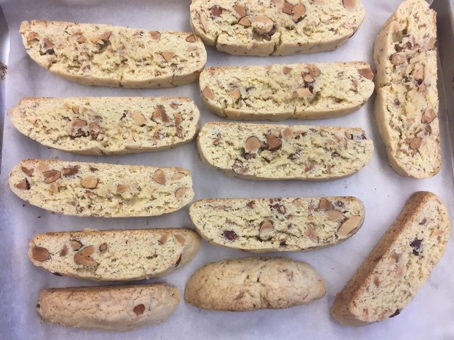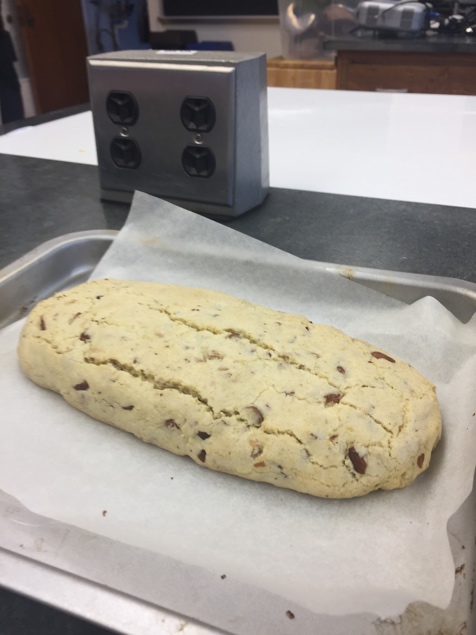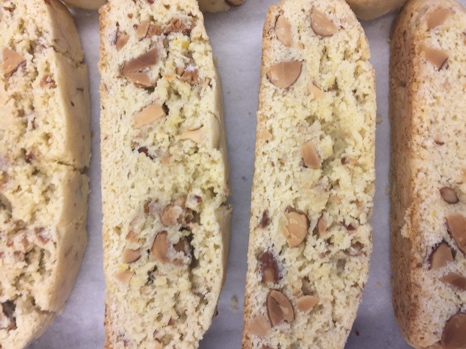“Biscotti” is the plural form of biscotto. The word originates from the medieval Latin word biscoctus, meaning “twice-cooked.” It defined oven baked goods that were baked twice, so they were very dry and could be stored for long periods of time. In modern Italian, the word biscotti refers to any cookie or cracker, just as does the British use of the word “biscuit”. The number of bakings or hardness is not relevant to the term. In America, the term “biscotti” refers only to the specific Italian cookie.

~these biscotti were made by Sp 2017 students
Supposedly, the most ancient Italian biscotti contained no fat of any kind which yield a very dry, very hard biscuit. Traditionally, ground almonds were mixed with sugar, eggs and flour; the dough was baked, sliced, and then baked again – hence, “twice baked”. The modern versions of biscotti are still firm, but they tend to be less “jaw-breaking” due to the addition of fat. Many Italians claim that the north of Italy more commonly used butter in their cooking, while the Mediterranean climate of Southern Italy made olive trees abundant, and olive oil the preferred fat.
In this lab, you will make both kinds and then compare them.
Variations: Traditionally, Meyer lemons are used for this dish, and the type of olive oil changes the flavor. Additionally, you can add a tiny bit of salt to the top of the biscotti before the second baking to add another layer of flavor.
Materials
- Baking Sheet
- Sturdy spoon or spatula for mixing
- large mixing bowl
- measuring cups and spoons
- parchment paper
- sharp knife for chopping
- serrated knife for slicing
Ingredients
“Southern Italian” olive oil biscotti |
Butter biscotti |
|
|
Special Note: If you have a tree nut allergy, complete the Chocolate Chip Cookie recipe instead.
Instructions
When you see text in boldface blue font. You should document that step with a photo within the narrative on your blog.
You are going to make two batches of biscotti with different fat sources: olive oil vs. butter. Complete the following procedure TWO TIMES, first with the olive oil recipe and then with the butter recipe.
- Preheat the oven to 350°F.
- Place the almonds on a baking sheet and toast them in the oven for 15 minutes, or until they are well browned and fragrant. Remove them from the oven (but leave the oven on) When the almonds are cool enough to handle, chop them finely.
- Combine the eggs, lemon zest, sugar, olive oil or butter, almond extract and vanilla in a bowl, and whisk together thoroughly.
- In another bowl, combine together the chopped almonds, flour, baking powder, and salt. Gradually add the flour mixture to the egg mixture, stirring thoroughly with a spoon. You may find that the olive oil biscotti needs a bit more flour. Add a little at a time by the teaspoon until the dough is stiff.
- Scoop each dough out onto a parchment paper–lined baking sheet, and shape it into a log about 6-8 inches long, 1 inch high, and 3 inches wide. The dough should be sticky, but not flowing wet—you may need to wet your hands slightly with water in order to work with it.
- Bake for 14 minutes. Rotate the baking sheet and bake for 14 more minutes. Remove from the oven and let the logs cool on the baking sheet for 12 to 15 minutes.

Twice Baked
- Reduce the oven temperature to 250°F.
- Transfer the logs to a cutting board. Using a serrated knife, slice the logs into ½-inch-thick biscotti. Put the biscotti on a parchment-lined baking sheet, spacing them ½-inch apart. Bake for 7 minutes. Rotate the baking sheet and bake for 7 more minutes, or until the biscotti are slightly crisp on the exposed sides. Transfer them to a wire rack and let them cool completely.

On your blog:
For your Blog:
- Integrate the photos you took (above) with a narrative about your process.
- Take Final photos
- Side-by-side of your completely cooled olive oil biscotti (labeled) and butter biscotti (labeled)
- Take a closeup photo of the biscotti interior, showing the texture.
- Post a brief video in which…
- You describe the texture of the olive oil vs butter biscotti – crunchy vs soft? crumbly?
- Describe what went really well during your biscotti making
- What would you change if you repeated this process again.
- Answer the following questions by copy/pasting the question and typing your answer on your blog:
- Why is butter a solid at room temperature while olive oil is a liquid.
- Butter is a fat that contains ~15% water, compared to olive oil (or shortening) which contains < 1% water. Read about the effects of this water content at this page (Water Activity and Cookie Softness) and then explain the textures of the two different types of biscotti.
- When mixing the ingredients you added the flour mixture slowly to the fat/oil mixture. What effect does the fat/oil have on gluten formation in the dough? What about your biscotti supports your conclusion?
